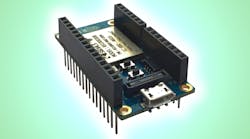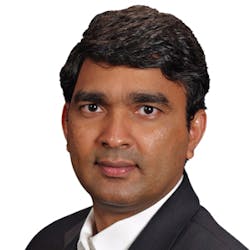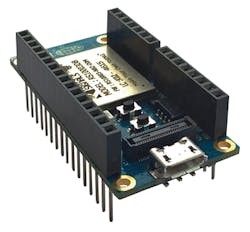This file type includes high-resolution graphics and schematics when applicable.
The IoT explosion is upon us. As developers look to further integrate connectivity and communication protocols into everyday devices, the need for purpose-built IoT development tools has become apparent. I caught up with Venkat Mattela, CEO of Redpine Signals, to discuss the latest in IoT development as well as the company’s new WyzBee platform (see the figure).
Wong: What trends do you see in IoT development?
Mattela: One of the biggest trends we’re seeing in IoT development is the push to develop greater and more efficient communication, not only between devices and the cloud, but from device to device as well. As developers and device makers grapple with the challenge of filling the world with connected devices, developers are looking for ways to make these devices a truly interconnected web. This, of course, requires communication.
The industry wants to see interconnected devices being fully compatible with each other and with controllers on the cloud. Today, communication is achieved through a variety of standards—from down at the physical layer to network-layer protocols. We think that this communication will always be heterogeneous, but this heterogeneity will not hamper the growth of the IoT.
At Redpine, we feel that IoT deployment will proliferate even within the current environment. At the link level, we see that communicating over IP is close to being universal. And Redpine has made it easier for even simple devices to communicate natively over IP by providing energy-efficient Wi-Fi that fits in with all of the constraints of such small, low-cost devices.
Wong: What are the biggest challenges that developers encounter with IoT?
Mattela: IoT provides a very complex framework that necessitates optimizing multiple areas to create a sustainable product. To properly create effective and efficient IoT solutions, developers need to leverage expertise in a number of technologies—including silicon, multiple wireless technologies, and application development—and it all needs to be done within the framework of the cloud.
To efficiently marry all of these technologies together for devices with oftentimes small, singular use cases can be a challenge, especially when it comes to wireless connectivity. Over the past decade, Redpine engineers have spent more than 3000 person years to integrate multiple wireless protocols, including Wi-Fi, Bluetooh, and ZigBee, on to the same chip, giving device makers a viable toolkit to cheaply and efficiently develop new IoT solutions.
Wong: You introduced your WyzBee development platform this summer. What exactly is WyzBee?
Mattela: The WyzBee platform is intended for a large variety of IoT applications. It includes hardware boards, an application development environment, a cloud software and services framework, as well as a product-synthesis solution for synthesizing the final product. The architecture is extensible and additional customizable modules, which we call THINGS, can be added for specific applications. The base platform provides the computing power, wireless connectivity, cloud integration and application framework that can be used by any application. Among the THINGS provided are GPS, GSM/GPRS, speech, relay, power profiling, and several sensor capabilities. These THINGS are targeted toward several key use cases, including home automation, smart energy, personal healthcare, medical applications, and industrial applications.
Wong: How does WyzBee differ from other IoT platforms?
Mattela: First of all, the WyzBee platform provides a highly optimized single-source solution for IoT device creation that employs product synthesis across a singular integrated hardware, software, cloud deployment, as well as mobile application development. It offers multi-protocol wireless connectivity, including Wi-Fi, Bluetooth, and Zigbee, to the IoT devices. Its highly integrated embedded software on-module connects to popular cloud-services platforms without the need for third-party proxy services. And it has advanced PUF security, which ensures highly secure transactions between devices.
The bottom line is that WyzBee dramatically reduces the time to market for developing IoT devices. Typically, it can take anywhere between two to eight months for a developer to incorporate wireless-capable hardware and integrate the associated software into their system. WyzBee is already equipped with a multi-protocol wireless module and comes with ready-to-use APIs. Because of this, the time involved in integrating wireless to a system is considerably reduced.
WyzBee also comes with on-board sensors and an IR receiver, which further reduces the required development time. Additional THINGS such as speech, GSM/GPRS and GPS can be stacked on top to achieve the desired functionality. Because of this, WyzBee mitigates the need to enter into the cycle of procurement, integration, and testing for sensing devices and control abilities into an existing system altogether.
Wong: How do you envision WyzBee changing the way IoT devices are developed?
Mattela: It’s important to understand that connectivity is fundamental to any IoT device. Without that connectivity, the IoT can’t exist. We developed the WyzBee platform to natively incorporate all forms of wired and wireless interfaces. This saves potentially weeks of effort normally taken in integrating and optimizing a wireless interface into an embedded system.
In addition, the WyzBee development environment integrates multiple steps in the device design process, and developers will be able to visualize and create the entire product in one flow—including the circuit, hardware, software, and cloud. However, an IoT development platform does not stop at that. With WyzBee, the core computing and connectivity components are available in a small, highly integrated module. Developers will be able to proceed with their form-factor design with assured small size, low price, and exact functionality and performance that they have already experienced with the WyzBee platform.




